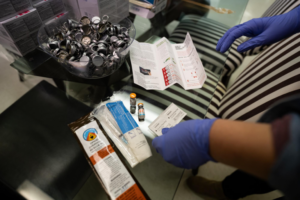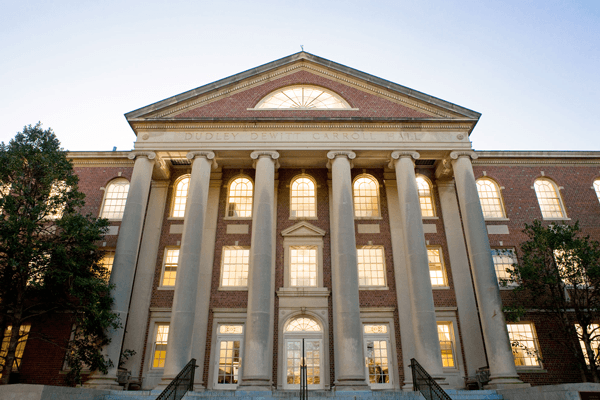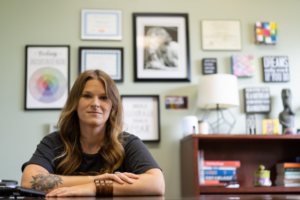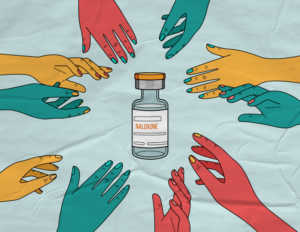
Story by Anna Mudd, Photos by Lucas Pruitt, Graphic by Stephanie Mayer
It was New Year’s Eve. Devin Lyall sat in the back bedroom of her drug dealer’s house.
Her thin fingers fumbled with the syringe. Her fingers weren’t the only frail thing about her—in the past few months she had lost about 40 pounds, leaving her practically skin and bones.
She was using Opana, a strong narcotic, melting the small, circular pills into a liquid that she could inject.
As the dregs of 2012 trickled into the New Year, Lyall didn’t have much hope. It was as if her life was ticking away as quickly as the seconds remaining before midnight.
She was shaking, chills running through her body, yet she was so hot she felt like she was on fire. She kept injecting, hoping it was the relief her body needed.
She woke up later, lying in a hospital bed. Her mother and father stood over her. She wasn’t sure when or how she had gotten there.
Lyall had overdosed.
The drug dealer had called her mother, who rushed her to Wilkes Medical Center. They made it in time for doctors to give Lyall the reversal drug Naloxone, saving her life.
“I remember in that moment feeling very helpless, but relieved,” Lyall said. “I was so glad that I wasn’t in that house anymore and that maybe I had an opportunity to do something different. It was the first time in a long time that I thought maybe I can get help.”
She began the new year in the ICU for seven days, a regular room for 10 more, and detox for 14 after that.
Naloxone is a drug that blocks the nervous system’s opiate receptors. It is most commonly used for drug overdoses—Narcan is a well-known brand name.
In August, Pfizer halted production of its single-dose injectable Naloxone, due to a manufacturing issue. This causes issues as buyers’ organizations distribute this Naloxone to many grassroots harm reduction coalitions across the state.
Dr. Nabarun Dasgupta, drug and infectious disease scientist at UNC Gillings School of Global Public Health, and others estimate the interruption would result in about 1 million fewer doses, which could lead to as many as 18,000 avoidable overdose deaths.
In 2012, the year Devin overdosed, Naloxone and overdose kits weren’t common in clinics, harm reduction coalitions, or other local organizations. Hardly any individual had them on hand. In a way, Devin was fortunate. She had a dealer who called her mother, and her mother responded. Many who overdosed at the time weren’t as lucky.
Now, Naloxone is more accessible — on pharmacy shelves, part of local syringe exchange programs, and often in first responders’ hands. This access is crucial, especially as opioid overdose deaths rose to an all-time high in North Carolina in 2020.
The change is largely a result of North Carolina’s 2016 Naloxone Standing Order which allows pharmacists to dispense Naloxone to those who need it and for community distribution. But addiction recovery experts say the Standing Order is not doing enough to blunt the rapid rise of opioid addiction.
“There’s a third tier of programs around the state that rely on other programs to purchase Naloxone for them,” Dasgupta says. “So, these are sponsored programs, programs run by people of color serving people of color, and they are ones that don’t have the official paperwork to buy and purchase Naloxone—but have the really critical infrastructure to get it to where it needs to go.”
Getting Naloxone to these local harm reduction groups is critical, because this is often where active users—who are most at risk—go for Naloxone.
The Standing Order only covers distribution—not purchasing. Pharmaceutical companies producing Naloxone require a prescription. This is where the nuances of the North Carolina’s Order stand in the way of easily getting Naloxone to the organizations where it is most effective.
“The Standing Order, it’s kind of a sham,” Dasgupta says. “Our legislature came up with a piecemeal, almost useless version of a law that created this Standing Order, then feel like they’ve done something and wash their hands of it. What would have really helped is for these smaller programs to be able to order Naloxone directly from pharmaceutical distributors.”
With rising overdoses, a flawed Standing Order, and a Pfizer Naloxone shortage, North Carolina faces what could be a nightmare.


Louise Vincent is the executive director of the NC Urban Survivors Union, a grassroots Greensboro group working to support and assure safety for opioid users in the community through syringe exchanges and by providing Naloxone.
“If I didn’t have Naloxone I couldn’t go to work’” Vincent says. “I could not look someone in the face and tell them I don’t have Naloxone and send them to die—because you’re literally sending someone off to die if you don’t have it.”
This reality landed on national consultant Robert Suarez’s doorstep at Urban Survivors just a few weeks ago. A young woman ran into the center screaming. Her friend was overdosing in her car right outside the clinic. Suarez grabbed two bottles of Naloxone, ran outside, opened the passenger side door, climbed on top of the overdosing man, and administered the lifesaving drug.
After he injected the Naloxone, Suarez said he gave him mouth-to-mouth during the four minutes it took the Naloxone to work.
“Four minutes is an eternity when someone isn’t breathing on their own,” Suarez says.
A month into Pfizer’s Naloxone shortage, the Urban Survivor’s Union supplies remain sufficient—for now.
But the fear of coming up short is pervasive.
“I’m acutely aware that there’s a shortage, and I want to be mindful,” Vincent says. “I cannot run out. I will not run out. Bottom line is I won’t run out. There’s expired Naloxone that I’ve already figured out how to access. We’re pretty scrappy people, I’m going to find it.”

At the R3 Recovery Center in Wilkesboro, N.C., Emily Church displays the materials that come in an opioid overdose kit, including two vials of Naloxone and an instruction manual. “I can get behind this because I’ve seen way too much death,” Church says. (Photo by Lucas Pruitt)
Another way harm reduction groups are coping with this shortage is by getting Naloxone from larger organizations across the state with the ability to purchase from other pharmaceutical distributors.
One of these groups helping provide Naloxone is Project Lazarus in Wilkes County. They have a medical director able to order the drug.
“We’ve worked with what stock we have, and every time we have looked at getting Naloxone it wasn’t just for ourselves,” says Fred Brason, executive director and founder. “I’ve given Louise Vincent Naloxone, I’ve given it to Twin Cities Harm Reduction.”
Brason explains that studies show that people who go to a pharmacy for Naloxone are usually family members or friends of a user, rather than the user themselves.
“Within the harm reduction circle there is a huge concern—there never has been the full access that is necessary to make the difference Naloxone can,” Brason says. “Any reduction from what was already not sufficient is going to create major problems.”
Tracy Coins, a waitress in Greensboro, relies on the Urban Survivors Union for Naloxone.
“The circle of people that I travel in wouldn’t go anywhere else but Urban Survivors” Coins says. “They don’t want to walk into places like CVS or Walgreens because those people are so judgmental.”
In August, Coins saved someone overdosing right in front of her with the Naloxone she had on hand.
She was with a group of people at a friend’s house, and they were all doing heroin. Suddenly, one man curled up, his body as tense as a rubber band stretched to its limits, his arms and legs locked up. Coins looked around the room and realized that no one had any idea how to help.
“I carry Naloxone with me all the time if I can,” she said. “The only place I get it is through Urban Survivors.”
Coins gave him Naloxone and mouth-to-mouth until he came to.
Local harm reduction agencies acknowledge that there are people who are going to use drugs. By providing Naloxone, and hosting syringe exchanges, they give these people the option to have a safer experience.
After Lyall’s near-fatal New Year’s Eve, she got clean. She gradually got her life back—her house, her kids, and she reconnected with her family.
Today, she is the founder and executive director of Wilkes Recovery Revolution.
Wilkes Recovery focuses on helping people overcome addiction, and is a harm reduction center—working to assure users are safe, distributing Naloxone, and trying to decrease stigma.
“Syringe exchange programs are truly the people that are boots on the ground,” Lyall says. “We’re the ones intersecting with people who use drugs and serving them on a daily basis, yet we are the last to get Naloxone, when I think it should probably the other way around, So, if there’s a shortage, then we’re definitely hurting at the grassroots level, as a syringe exchange.”
Pfizer expects its Naloxone shortage to continue through February 2022, leaving harm reduction groups to continue relying on sources whose Naloxone supplies are diminishing.
Lyall says she had a wonderful life before her addiction. A supportive, upper middle-class upbringing. A good job and a family of her own.
When she slipped down some icy stairs at a ski resort, shattering her ankle, she had no idea that the pain medicine she would be prescribed would be the start to a crippling addiction.
Now, Lyall reflects on pulling herself out of the depth of her addiction, how difficult this was, and how lucky she was to get Naloxone in time to save her life.
At Wilkes Recovery Center, she wants to give people this same chance.
“When I moved back home, my mission was to give other people the opportunities that I had,” she says. “I understand that I was a privileged person and that not everybody gets those same options and opportunities and that I was very lucky to have.”
 Stories from the UNC Media Hub are written by senior students from various concentrations in the Hussman School of Journalism and Media working together to find, produce and market unique stories — all designed to capture multiple angles and perspectives from across North Carolina.
Stories from the UNC Media Hub are written by senior students from various concentrations in the Hussman School of Journalism and Media working together to find, produce and market unique stories — all designed to capture multiple angles and perspectives from across North Carolina.


